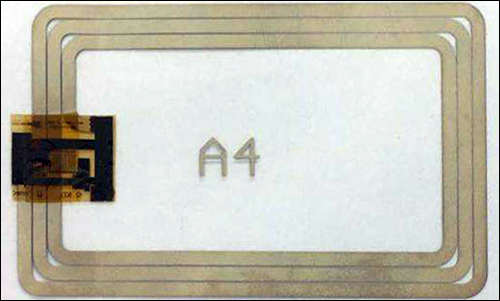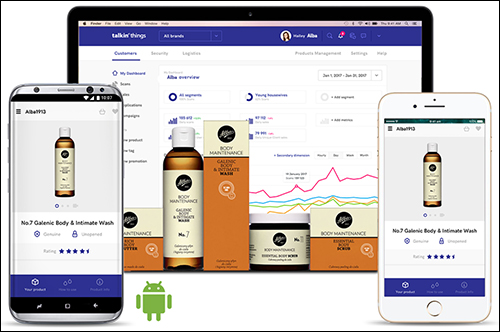Jun 15, 2017The following are news announcements made during the past week by the following organizations: Purple Deck Media; Talkin' Things; Quad Industries, Agfa, Imec, TNO; GE Healthcare, Zebra Technologies; and Versus Technology.
Purple Deck Media Announces NFC System Compatible With Apple Products
Purple Deck Media has announced that TapLive, its Near Field Communication (NFC) solution for small to enterprise-level businesses, is now compatible with Apple products starting with iPhone 7 and newer models. The development follows Apple's recent announcement at its World Wide Developers Conference that its iOS 11 operating system will support the reading of NFC tags (see Apple Embraces NFC—Finally).
"With TapLive, NFC tags become dynamic," said James Sulfare, Purple Deck's CEO, in a prepared statement. "The tags are coded, locked and security protected, and the content that they deliver is entirely cloud-controlled so it can be managed from an easy-to-use dashboard. For consumers, this creates a seamless, interactive experience where they can access information by simply tapping their device to a tag. This encourages customer engagement within a store, while giving managers valuable insight by collecting a host of data and analytics."
According to Purple Deck Media, a 2014 report estimated that the U.S. market for proximity marketing, which includes advertising, shopper marketing and m-commerce opportunities, would reach $37.6 billion by 2016. However, the company reports, the market has fallen short of this goal because Apple had previously only enabled NFC technology on its devices in the limited form of Apple Pay, the company's own payment system.
According to the Apple Developer website, CORE NFC will "enable your app to detect NFC tags, visit certificates, identifiers and profiles... For example, your app might give users information about products they find in a store or exhibits they visit in a museum."
"This development will definitely generate increased interest and adoption of NFC technologies now that one of the most widely used platforms in the U.S. is involved," said Nathan Neil, Purple Deck's COO, in the prepared statement. "Apple's announcement is what the developers, consumers and partners already working in the NFC space have been waiting for."
Talkin' Things Releases NFC Smart Packaging for iPhone, Android
Talkin' Things has announced that its Smart Packaging System will take advantage of Apple's decision to let iPhone users scan Near Field Communication (NFC) tags implemented in smart products. The software update is dedicated for iPhone 7 and 7 Plus, and is expected to arrive with the release of iOS 11 this fall.
"The integration of end customers with iPhones to our Smart Packaging System is a game changer for our clients and all brand owners looking for a reliable technology," said Marcin Pilarz, Talkin' Things' CEO, in a prepared statement. "From this point, they will be able to offer smart products to additional 120 million users of iPhone 7 and 7 Plus worldwide. This is a tremendous opportunity for smart packaging and the whole IoT industry."
The Smart Packaging System is intended for use by both iPhone and Android users. By implementing the system into packaging, the company says it has created a product communication platform that provides protection against threats related to a brand.
Smart packaging enables products to advertise themselves on a shelf and communicate with customers via the tap of a smartphone. Talkin' Things solution makes it possible to register sales without any integration with a cashier system. It creates various possibilities for brand owners to increase sales, by rewarding consumers for purchases and running marketing campaigns based on customer behavior analysis and big data.
Quad Industries, Agfa, Imec, TNO Demo Plastic 12-bit RFID Tag and Readout System With Screen-Printed Circuitry
Quad Industries, Agfa, imec and TNO have announced that they have demonstrated a plastic 12-bit RFID tag and readout system with screen-printed circuitry. The system integrates a screen-printed antenna and printed touch-based user interface, allowing implementation of the reader on curved surfaces. The demonstrator has been designed for badge security applications, the company reports, but could also be used for other applications, including smart packages, wearables and interactive games.
RFID tags made of plastics electronics offer specific advantages over silicon-based identification devices, according to the company. They can be affixed to curved packaging and incorporated into everyday objects, and can accommodate inexpensive manufacturing. Typical applications include item-level identification, smart food packaging, brand protection and badge security. RFID tags need to be scanned by a dedicated RFID reader that is typically within 2 centimeters of the tag.

Imec, Quad Industries and Agfa have integrated a screen-printed antenna in both the RFID tag and the readout system. This allows for an optimal integration of both devices on a variety of surfaces. The antennas have been screen-printed by Quad Industries, using printing inks from Agfa.
The partners have demonstrated the new technology in a badge security application. The access badge combines the credit-card-sized printed antenna with a plastic 12-bit RFID chip, integrated on a flexible plastic substrate. The RFID tag is manufactured in imec's metal-oxide thin-film transistor (TFT) technology. This technology uses large-area manufacturing processes that allow for inexpensive production in large quantities. The 12-bit RFID developed for this demonstration contains 438 TFTs.
The readout system contains innovative printed functionality at different levels. An RFID readout antenna is screen-printed on a plastic film, allowing optimal integration on flat, curved or 3D-shaped reader surfaces. Between the cover lens and the display, a fully printed touchscreen interface with a numerical keypad allows users without a badge to access the building by entering a numerical code. The touchscreen was printed using highly transparent screen-printed inks.
"Newly developed nanoparticle based Ag inks allow to achieve much lower resistances over conventional Ag-flake based inks enabling to directly integrate new functionalities by screen printing," said Wim Christiaens, Quad Industries' R&D director, in a prepared statement. "Moreover, the antenna is printed at the same level of the printed touch screen, resulting in direct, more cost-effective integration of both the printed antenna and the customized touch screen in the reader device."
"This demonstration is a noteworthy example of hybrid flexible electronics, combining the advantages of plastic electronics with metal-oxide TFT technology developed by imec and TNO," said Kris Myny, a principal member of the technical staff at imec, in the prepared statement. "The technology allows for low-cost screen-printing manufacturing, is easily customizable and eco-friendly, and enables direct chip integration on various substrates including plastics, paper and more. The technology promises applications in smart packaging, smart gaming and smart PCB."
The prototype system is being demonstrated at the SIM User Forum in Antwerp, Belgium. The work on printed conductive structures is carried out as part of the Flemish Met@link project. The work on transparent touch screens is carried out by Quad Industries under the framework of the European INREP project, which received funding from the European Union's Horizon 2020 research and innovation program under grant agreement #641864. The work on flexible RFID technologies is performed in Holst Centre, an open innovation initiative set up by imec and TNO.
GE Healthcare, Zebra Technologies Bring BLE Wireless Asset-Tracking Technology to Hospitals
GE Healthcare has introduced its Encompass solution, designed to help hospitals manage mobile asset inventories, reduce cost of ownership and achieve better capital allocation. It enables health-care providers to find critical mobile assets in real time so that they can spend less time searching for equipment and more time focused on providing quality patient care.
During the past 15 years, real-time location systems (RTLSs) have been proven to help hospitals improve the management of critical mobile clinical assets, and to save millions of dollars in capital and maintenance costs. However, significant obstacles around the implementation of traditional RTLS solutions, including large capital expenditures and long, disruptive deployment programs, have limited its market penetration to just 15 to 20 percent.
Encompass helps facilities enable better patient care, operational efficiency and financial performance, according to the ompany. The system is built upon open standards and commercial Bluetooth Low Energy (BLE) wireless technology that leverages a hospital's existing Wi-Fi network. It can be installed within a matter of days, and without opening ceilings or a need to drill into walls to run cable. The capital and installation cost is up to 60 percent lower than for cabled RTLS solutions, the firm reports, and there is no requirement for separate, dedicated onsite application and database servers for the hospital to maintain, and no dedicated software to update.
The applications can be provided as a subscription service. The system can be scaled to accommodate growth, and can be reconfigured if hospital layouts are redesigned or repurposed. As a cloud-based application, the system is accessible by any authorized staff member and from any computer or mobile device with internet access.
"Zebra is pleased to collaborate with GE Healthcare as we see transformative value from this innovative, practical, and easy-to-implement solution," said Chris Sullivan, Zebra Technologies' global health-care practice lead, in a prepared statement. "With Enterprise Asset Intelligence built by real-time visibility, clinicians now have reduced operational distractions and a greater ability to maximize their focus on patient care. This is a good thing for all of us, and contributes to a higher-quality, lower-cost patient care environment."
Versus Technology Offers RTLS for BLE Wayfinding
Versus Technology has announced that health-care facilities seeking to improve the patient experience through wayfinding initiatives can now leverage its real-time locating system (RTLS), providing power and simplifying maintenance for Bluetooth Low Energy (BLE) networks.
Wayfinding apps for smartphones can ease patient anxiety as they navigate large health-care campuses, providing turn-by-turn directions, the company explains, yet installing BLE beacons for wayfinding typically creates a standalone network that requires active supervision and maintenance. Changing beacon batteries and ensuring that none go missing due to theft are crucial to providing a seamless wayfinding experience for patients.
The Versus Sensor Plus is designed to address these issues for health-care facilities that use the Versus RTLS. With Sensor Plus, Versus customers can expand their RTLS investment to provide a plug-and-play power source for BLE beacons, eliminate the need to change beacon batteries, hide beacons from sight and possible theft, and improve beacon performance through optimal placement in hallway ceilings.


